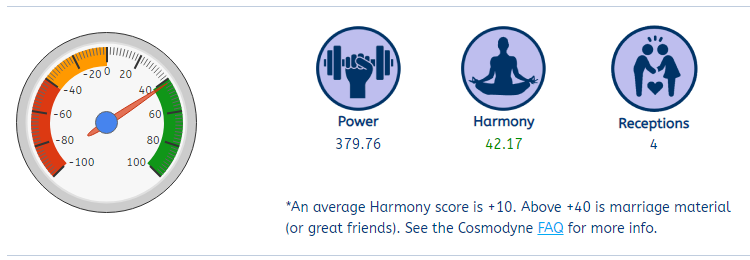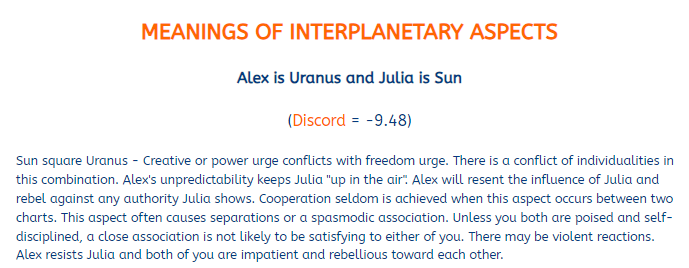We use cookies to personalize site content, social media features and to analyze our traffic. We also share information about your use of this site with our advertising and social media partners.

A Guide to our Synastry Report


What exactly is Synastry?
Synastry is an astrological technique that compares the birth charts of two people. It shines a light on their relationship dynamics, whether they're potential lovers, friends, or business associates.

Why is it important?
Synastry can reveal strengths, hurdles, and themes in all of your relationships, helping you navigate potential connections at a deeper level.
Consider this: Let's say you're a Cancer Sun and you find a potential match on MatchMachine™ whose Moon is in Cancer, you can almost guarantee that you will feel an instant sense of understanding with this person. With this configuration, it's as if you're both singing the same emotional tune.
Or, if your Venus—the planet of love—has a friendly link with a potential match's Mars—the planet of desire, it could signal a strong romantic or sexual spark. Like two pieces of a puzzle fitting perfectly together, you could find an irresistible attraction brewing.
On the other hand, if your Mercury (communication) forms a challenging aspect with a potential match's Neptune (dreams and illusions), you might need to pay extra attention to communication. Clear, straightforward conversations could be the key to avoid misinterpretations.
Most Astrology sites and dating apps give you limited information about your Astrological compatibility. Many don't even tell you the Astrological elements that are based on their vague descriptions.
At MatchMachine™, we take an entirely different approach. We show you exactly which Astrological elements are involved and order the descriptions by their Power and Harmony so that you can get a clear picture for how bad the bad things are, and how good the good things are.

We do Synastry Reports in a whole new way.
The secret lies in our use of DupleDynes. By incorporating the concept of Cosmodynes, DupleDynes allow us to pinpoint the Astrological Power and Harmony between each aspect in the charts of the pair in question.
What are Cosmodynes and DupleDynes?
Cosmodynes are a method used in astrology to measure the strength of planets, signs, and houses in a person's natal chart. Building upon this, DupleDynes go one step further. They're like a mathematical superpower that compares the conditions of each planet of one person to each planet of another person.
(DupleDynes Example for "Alex" and "Julia")

.png)
Harmony points are awarded for favorable synastry aspects, such as mutual receptions, trines, and conjunctions from benefic (or helpful) planets.
On the flip side, Harmony points drop when there are unfavorable aspects like Squares, oppositions, and conjunctions with malefic (or challenging) planets. Adding up all these points, we arrive at an overall Harmony Score.
The result? A clear Harmony and Power score for each of these conditions.
MatchMachine™ takes each of these individual data points and orders the descriptions in your Synastry Reports from the most Discordant to the most Harmonious. This way, even if you have a favorable DupleDyne harmony Score, you can instantly understand the greatest energy blockages between you.
Let's dive into an example.
Below is a section of Alex and Julia's Synastry Report. Even though Alex and Julia have a (high) total Harmony score of 42.17, no relationship is perfect, and MatchMachine™ shows you the most discordant aspects first, so that one can immediately see the source of the worst possible conflicts and energy blockages.


And what about Power?
Power refers to the strength or influence an aspect can have, which is determined by the precision of the angles between the planets in question.
This precision is embodied in the concept of "Orb", which represents the exactitude of an aspect—whether it's a Trine (120 degrees), Conjunction (0 degrees), Opposition (180 degrees), Square (90 degrees), or Sextile (60 degrees)—between two celestial bodies.
The smaller the orb, or the closer the actual angle is to the exact angle of the aspect, the stronger and more profound the influence exerted on the relationship between the two individuals under consideration.
In the context of synastry, a "3-degree orb" refers to a situation where the aspect between two comparable points (between 2 people's charts) is within 3 degrees of the exact angle required for a specific aspect.
For example, if Person A's Venus is at 15 degrees Taurus and Person B's Mars is at 18 degrees Virgo, there is a (favorable) Trine (120 degrees) aspect with a 3-degree orb.
This close alignment suggests a potent connection and potentially harmonious interaction between the Venusian and Martian energies of these individuals, with Venus symbolizing love and affection, and Mars representing drive and passion. This is interpreted as a strong bond or significant compatibility between the two people in terms of their love life or sexual attraction.
![]()
In astrology, mutual reception is a concept where two planets are in each other's ruling signs, which forms a special connection between them. It's essentially like they are "visiting each other's homes," and this dynamic can significantly influence an individual's birth chart interpretation.
In synastry, mutual reception occurs when person A's ruling planet is in the sign ruled by person B's ruling planet, and vice versa. Mutual receptions can create a strong bond and understanding between the individuals involved.
Let's consider two examples:
Let's say that in person A's chart, their Venus is in Leo, and in person B's chart, their Sun is in Taurus. This is a mutual reception because Venus rules Taurus and the Sun rules Leo. This kind of mutual reception can suggest a powerful bond in the realm of love and attraction. Person B may appreciate and admire the way person A expresses love and affection, while person A may be drawn to person B's warmth, generosity, and leadership. It can create a harmonious bond where each individual is appreciative and understanding of the other's romantic expression.
Similarly, let's consider person A's Mars is in Capricorn, and person B's Saturn is in Aries. This is also a mutual reception because Mars rules Aries and Saturn rules Capricorn. This mutual reception could indicate a strong, dynamic working relationship where each person respects and values the other's approach to challenges, work, and responsibilities. Person A may appreciate person B's disciplined and ambitious approach (Saturn in Aries), while person B may be drawn to person A's strategic, controlled energy and drive (Mars in Capricorn).
Just like in natal astrology, in synastry too, the exact nature of the relationship and how these energies play out can depend on other aspects of the two individual's charts. Astrology is multifaceted, and many other factors come into play when analyzing relationships between two people.
.png)
Looking for someone you'll truly vibe with?
Sign Up for Free today!
|
Ben Baker, CEO About the Author Ben has practiced Astrology for over 35 years and is a certified Cognitive Behavioral Therapist (CBT) Practitioner. Ben holds 11 patents for the core functions that all dating sites now use today. See Ben's Bio for more info. |
Comments